MARIANI’S
March
27,
2011
NEWSLETTER
Click Here to return to John Mariani's Homepage

First Edition
Published October, 1958
This
Week
Dining
Out
In Wales
by John Mariani
New York
Corner: Gotham Bar and Grill
by John Mariani
The Food
Scene in the Caribbean...And Where to Eat When In Aruba
by Christopher Mariani
Notes From the Spirit Locker: Muscat Is
More than Its Aroma
by Mort Hochstein
❖❖❖
GOOD
NEWS! Esquire.com now
has
a
new
food
section
called
"Eat
Like
a
Man,"
which
will
be
featuring
restaurant
articles
by
John
Mariani
and
others
from
around
the
USA.
THIS WEEK: Great
Moments
in
Italian
Food History
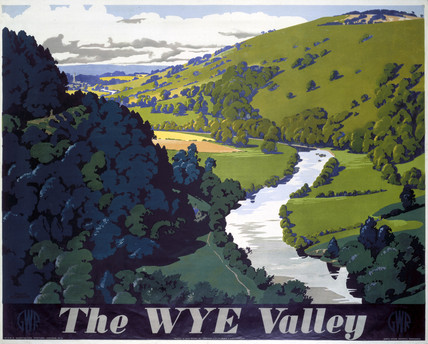 I doubt many people
have the
foggiest idea what Welsh cuisine is, except for Welsh rarebit--that
staple of
1940s and 1950s ladies' luncheons, consisting of nothing more than
melted
cheese over toast, usually with the addition of a little mustard and
cayenne
pepper. The dish has been around for centuries--basic as it is--first
mentioned
in print in 1725. But no one has ever satisfactorily explained the
origin of
the name. Some surmise that it might be a word play on poor people
having
cheese instead of meat as a rare bit. Actually, "rarebit" seems a
corruption of "rabbit," perhaps used in the way mock turtle soup
contains no turtle meat.
I doubt many people
have the
foggiest idea what Welsh cuisine is, except for Welsh rarebit--that
staple of
1940s and 1950s ladies' luncheons, consisting of nothing more than
melted
cheese over toast, usually with the addition of a little mustard and
cayenne
pepper. The dish has been around for centuries--basic as it is--first
mentioned
in print in 1725. But no one has ever satisfactorily explained the
origin of
the name. Some surmise that it might be a word play on poor people
having
cheese instead of meat as a rare bit. Actually, "rarebit" seems a
corruption of "rabbit," perhaps used in the way mock turtle soup
contains no turtle meat.
You will find Welsh rarebit/rabbit (below) in just about every
pub in the region, a poor advertisement for Welsh
gastronomy, composed of not much more than its basic elements, which
anyone
elsewhere would just call a grilled cheese sandwich. But in fact, Wales
has a
robust food culture, with plenty of hearty, quickly cooked dishes like Tatws Pum
Munud, made with potatoes, vegetables, and bacon on the
stovetop, and a good
array of stews like cawl, made
with
lamb
and
leeks. 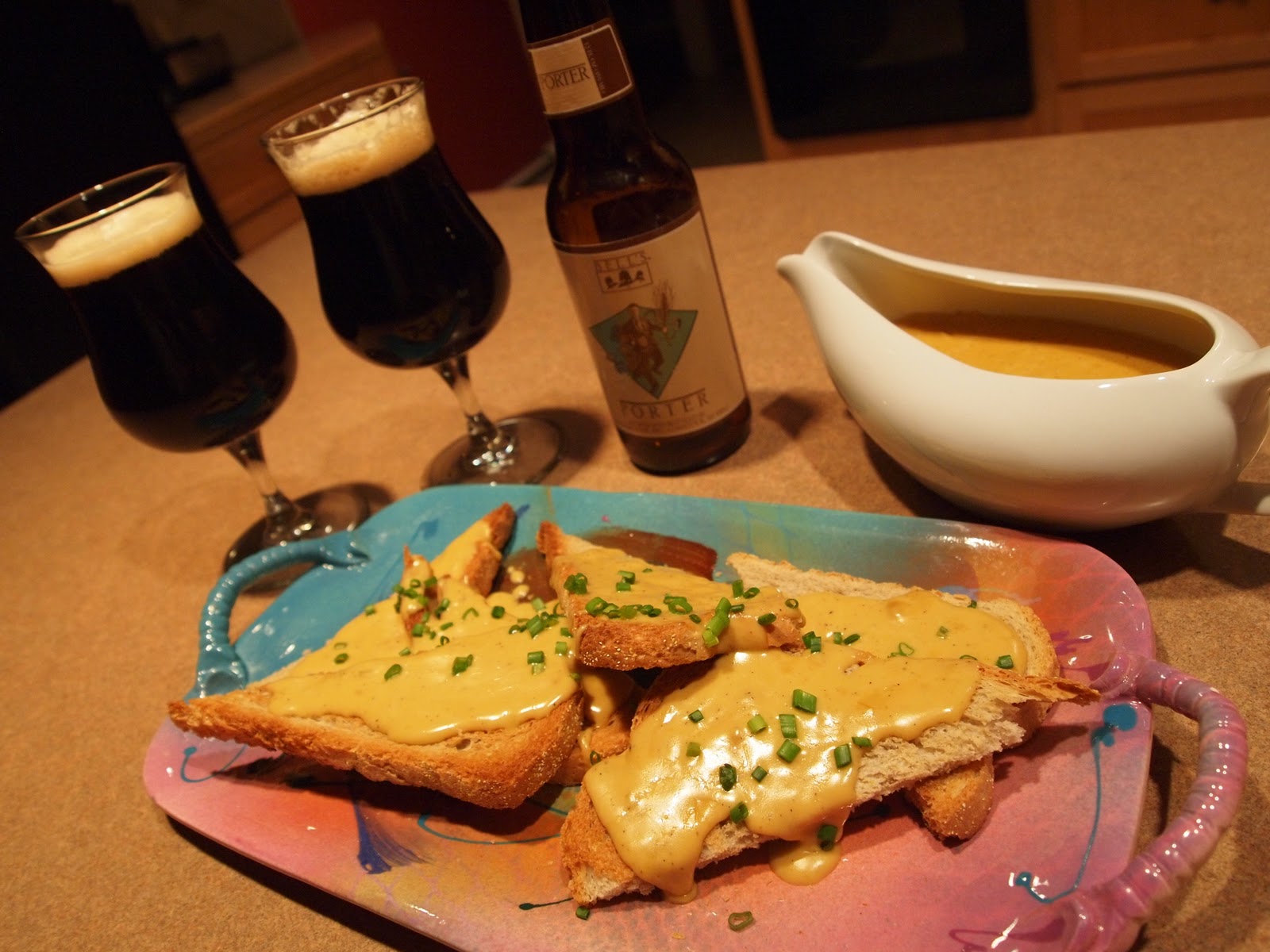 Bara brith
("speckled bread") has a sweet taste, made with raisins, currants and
candied peel, while crempogau
are buttermilk pancakes, and bara
lawr is laver
seaweed and oatmeal made into patties fried in bacon fat.
Bara brith
("speckled bread") has a sweet taste, made with raisins, currants and
candied peel, while crempogau
are buttermilk pancakes, and bara
lawr is laver
seaweed and oatmeal made into patties fried in bacon fat.
Caerphilly (below)
is
a
raw
cow's
milk cheese made around Cardiff,
once a very simple, mild cheese, often pushed out in large
factory bulk. Once, miners
would wrap them in cabbage leaves for lunch. There are, however,
artisans who
make some first-rate Caerphilly, creamy, sought-out brands like 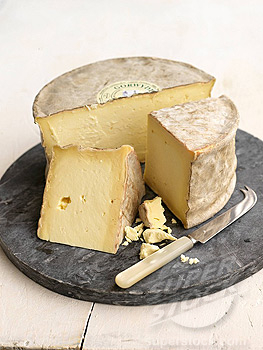 Duckett's
(though that one is actually made in England), Caws Cenarth, and
Glynhynod
all worth searching out.
Duckett's
(though that one is actually made in England), Caws Cenarth, and
Glynhynod
all worth searching out.
There is some wine made in Wales--20 working
vineyards--and,
since 1998, Penderyn makes a fine whiskey. But Wales is a
beer-loving country and brands
like S A Brain and Felinfoel
are easily found.
I'd like to report that my pub visits in Wales
revealed a
thriving food culture, but just as in England and Scotland, the fare is
pretty
much the same in every pub and pretty dreary stuff. You might,
therefore, want to consult the
annual Good
Pub Guide for more in-depth coverage. But if you want to
dine much
higher on the hog, consult Welsh Rarebits: Hotels of Distinction 2011 for
a
collection
of
more
than
50 of the country's finest hotels, townhouses,
inns
and restaurants. On my recent trip to Wales I ate splendidly at
several
such places, from menus both classic and up-to-date prepared by young
chefs who
are as knowledgeable about where to find the best local, just-shot
grouse and
Welsh cheeses as their employers are the best Burgundy wines.
Fairy Hill (right), set in an 18th century
stone house on
24 acres of parkland in Gower, 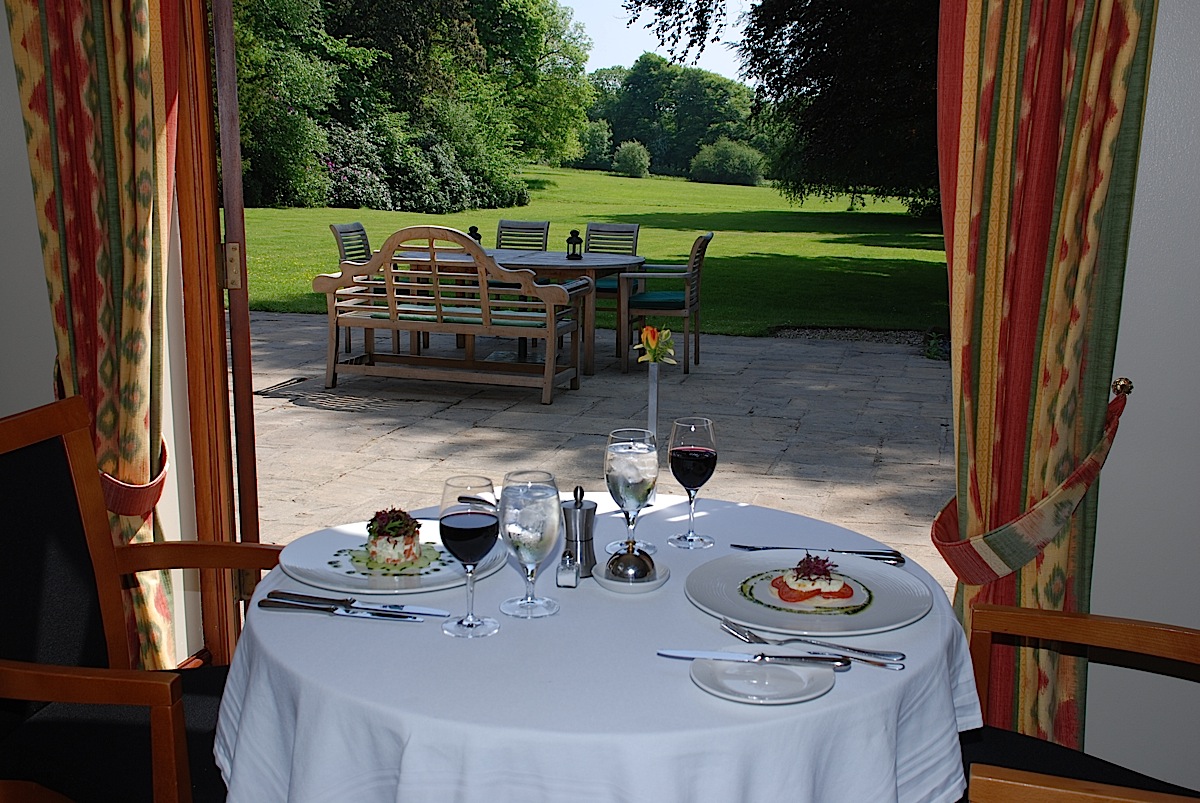 has eight cozy rooms and an excellent
restaurant
that draws its provender and ducks from their own walled garden, and
the
Gower Peninsula holds a bounty of sea bass, sewin, laverbread, samphire
and cockles,
and also gives its lamb the flavors of the salt marsh. The wine list is
excellent. Y
has eight cozy rooms and an excellent
restaurant
that draws its provender and ducks from their own walled garden, and
the
Gower Peninsula holds a bounty of sea bass, sewin, laverbread, samphire
and cockles,
and also gives its lamb the flavors of the salt marsh. The wine list is
excellent. Y
You might begin, then, with a Welsh goat's cheese and beet salad with toasted walnuts,
or a finely textured tian of Welsh crab with rich yellow mayonnaise,
tomatoes and
avocado. Scallops are seared and spiced with cumin, served with a
cauliflower
puree, black pudding and the unexpected appearance of chorizo. Duck from
the Penrhiw farm comes with a liver parfait and sweet jelly wine, while
brill
fillets take on chard with an herbed polenta in a Swansea Bay mussel
broth. Of course, there is fine Welsh beef, with hand-cut fried
potatoes,
a confit of tomatoes, and bok choi,
lavished
with
yellow
Béarnaise
sauce.
For dessert don't miss the treacle and almond tart--marvelously sticky
stuff--with the crisp nougatine, custard and clotted cream. And
you will
sleep well.
Two courses run £35,
three £45.
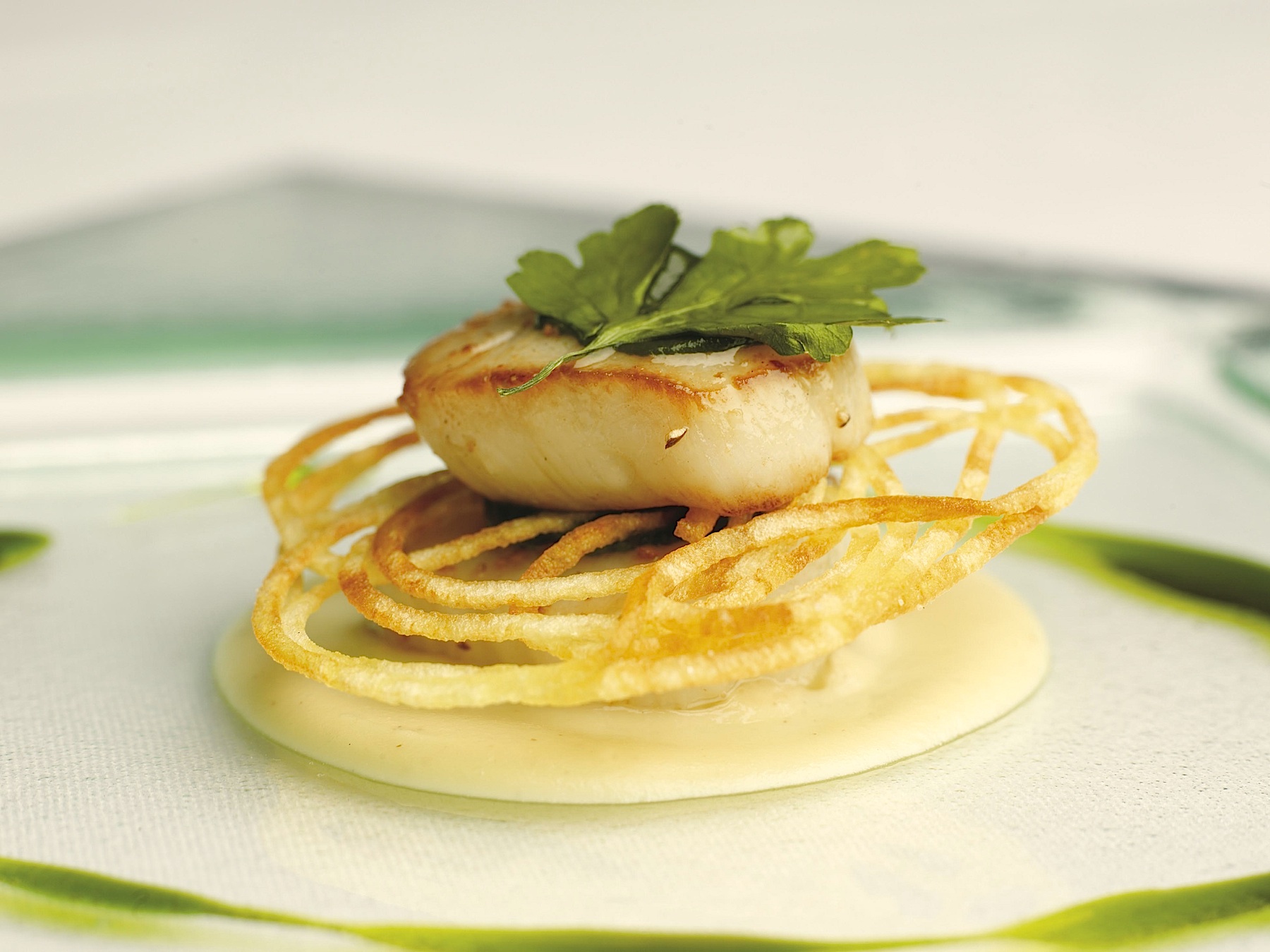 On
another evening we dined at
Ynyshir Hall in
Eglwysbach (once owned by Queen Victoria), which we found after
twirling through
narrow country roads whose palisades-like stone walls turn every turn
into a
hairpin. You can roam the 124 bucolic acres here, quietly as a
dormouse, entertained by the residents eh inhabitants of a highly
renowned bird sanctuary. Within the hotel it is as quiet, tufted
and comfortable as a location setting for a BBC series from a Thomas
Hardy novel,
though not so dramatically charged. The Dovey estuary is also a
Welsh Biosphere Reserve.
On
another evening we dined at
Ynyshir Hall in
Eglwysbach (once owned by Queen Victoria), which we found after
twirling through
narrow country roads whose palisades-like stone walls turn every turn
into a
hairpin. You can roam the 124 bucolic acres here, quietly as a
dormouse, entertained by the residents eh inhabitants of a highly
renowned bird sanctuary. Within the hotel it is as quiet, tufted
and comfortable as a location setting for a BBC series from a Thomas
Hardy novel,
though not so dramatically charged. The Dovey estuary is also a
Welsh Biosphere Reserve.
The dining
room has a chummy intimacy,
meaning you will be on nodding acquaintance with others in the sea
blue-green, well-set, flower bedecked room with textured tall chairs
and modern art. Here we began with smoked haddock with poached egg and
new potatoes, then Borth Bay cockles with lava bread served on soda
bread toast. A serving of smoked wild salmon was silky and delicious,
enriched with scrambled egg and chives, then omelets with cheese and
ham, treacle-cured bacon, sausages, lava bread, and black pudding. Oh,
I didn't mention this was just breakfast.
For dinner Chef Shane Hughes achieves a balance of
the sumptuous with the simple, evident in dishes like his starter of
cod and scallops with lightly curried potato, onion cream and shallot
crisps. 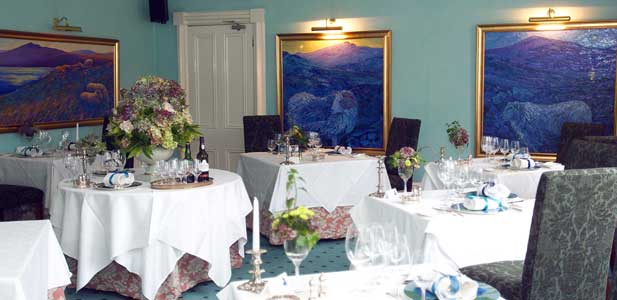 Large-breasted quail is poached and roasted, with a
quail's egg ravioli, cream cheese, and lovely green pea puree, while
rock oyster and langoustine comes with an oyster cappuccino.
Excellent Welsh lamb is treated to an accompaniment of asparagus
tortellini, crayfish, lamb's tongue lettuce and salsify. And for
dessert there is a dark chocolate fondant with spiced toffee, bay leaf
ice cream (not wise) and berry jelly. Or you might opt for the Welsh
cheeses. The wine list is first rate in every budget category.
Large-breasted quail is poached and roasted, with a
quail's egg ravioli, cream cheese, and lovely green pea puree, while
rock oyster and langoustine comes with an oyster cappuccino.
Excellent Welsh lamb is treated to an accompaniment of asparagus
tortellini, crayfish, lamb's tongue lettuce and salsify. And for
dessert there is a dark chocolate fondant with spiced toffee, bay leaf
ice cream (not wise) and berry jelly. Or you might opt for the Welsh
cheeses. The wine list is first rate in every budget category.
A 3-course dinner is £25 with 6-courses at £72.50,
and 10 at £90.
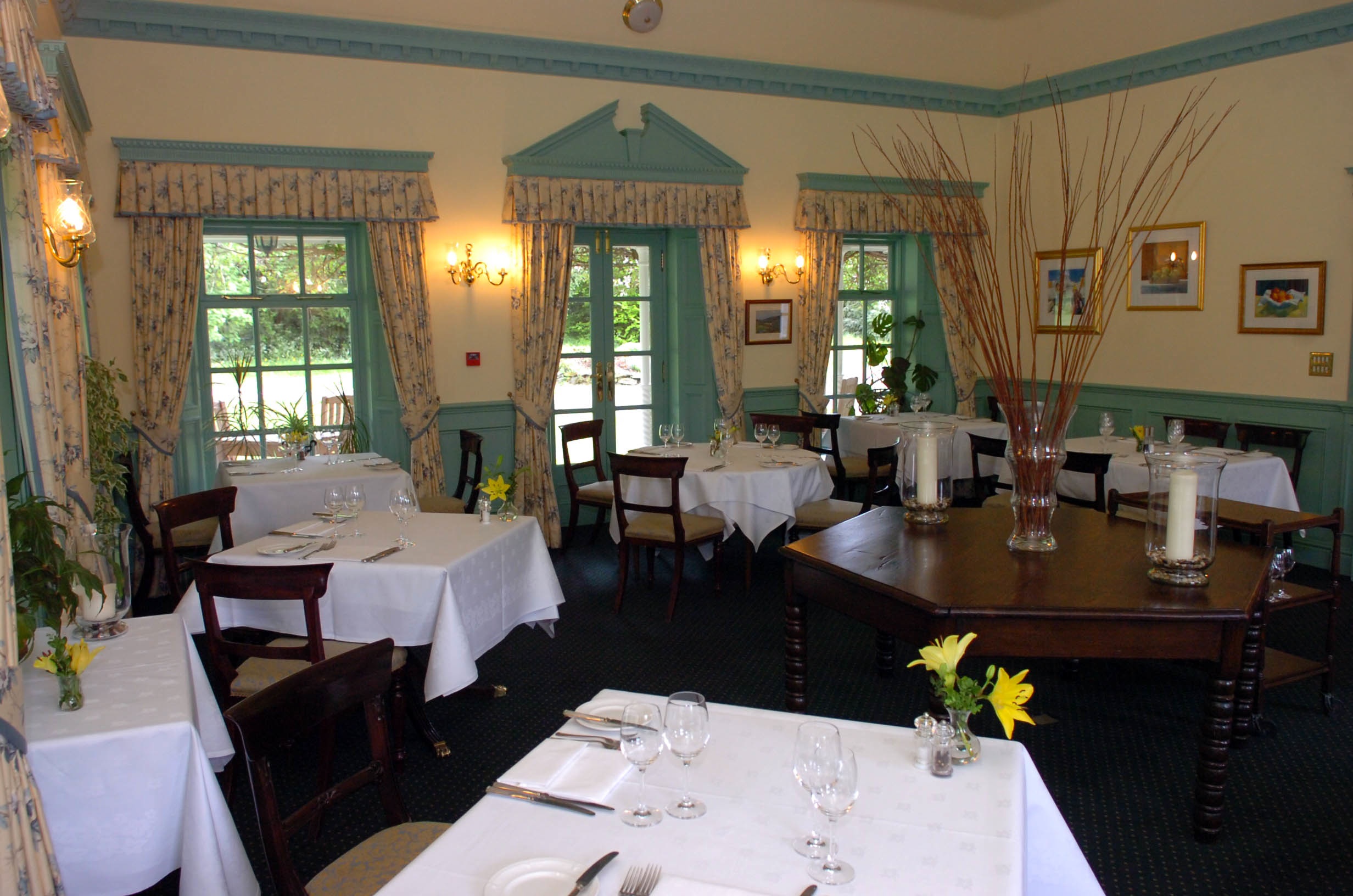 Our
last night in Wales was spent at Tyddyn
Llan near Chester and Llandrillo, at the tip of Snowdonia.
Owners Bryan and Susan Webb call their proud labor of love a
"Restaurant with Rooms," and those rooms are splendidly appointed, as
is the country dining room with its own simple, well-groomed elegance
and its view over the green lawns and forest. (ask them to turn up the
low lighting here to provide some buoyancy). Here you begin with a
proper dressed crab scented with fennel and a delicious pea shoot
salad, or perhaps a foie gras parfait with onion chutney. You sip
a little wine from a list rich in Bordeaux and Burgundy, with a good
sampling of other European labels, then choose among leek,
Our
last night in Wales was spent at Tyddyn
Llan near Chester and Llandrillo, at the tip of Snowdonia.
Owners Bryan and Susan Webb call their proud labor of love a
"Restaurant with Rooms," and those rooms are splendidly appointed, as
is the country dining room with its own simple, well-groomed elegance
and its view over the green lawns and forest. (ask them to turn up the
low lighting here to provide some buoyancy). Here you begin with a
proper dressed crab scented with fennel and a delicious pea shoot
salad, or perhaps a foie gras parfait with onion chutney. You sip
a little wine from a list rich in Bordeaux and Burgundy, with a good
sampling of other European labels, then choose among leek, 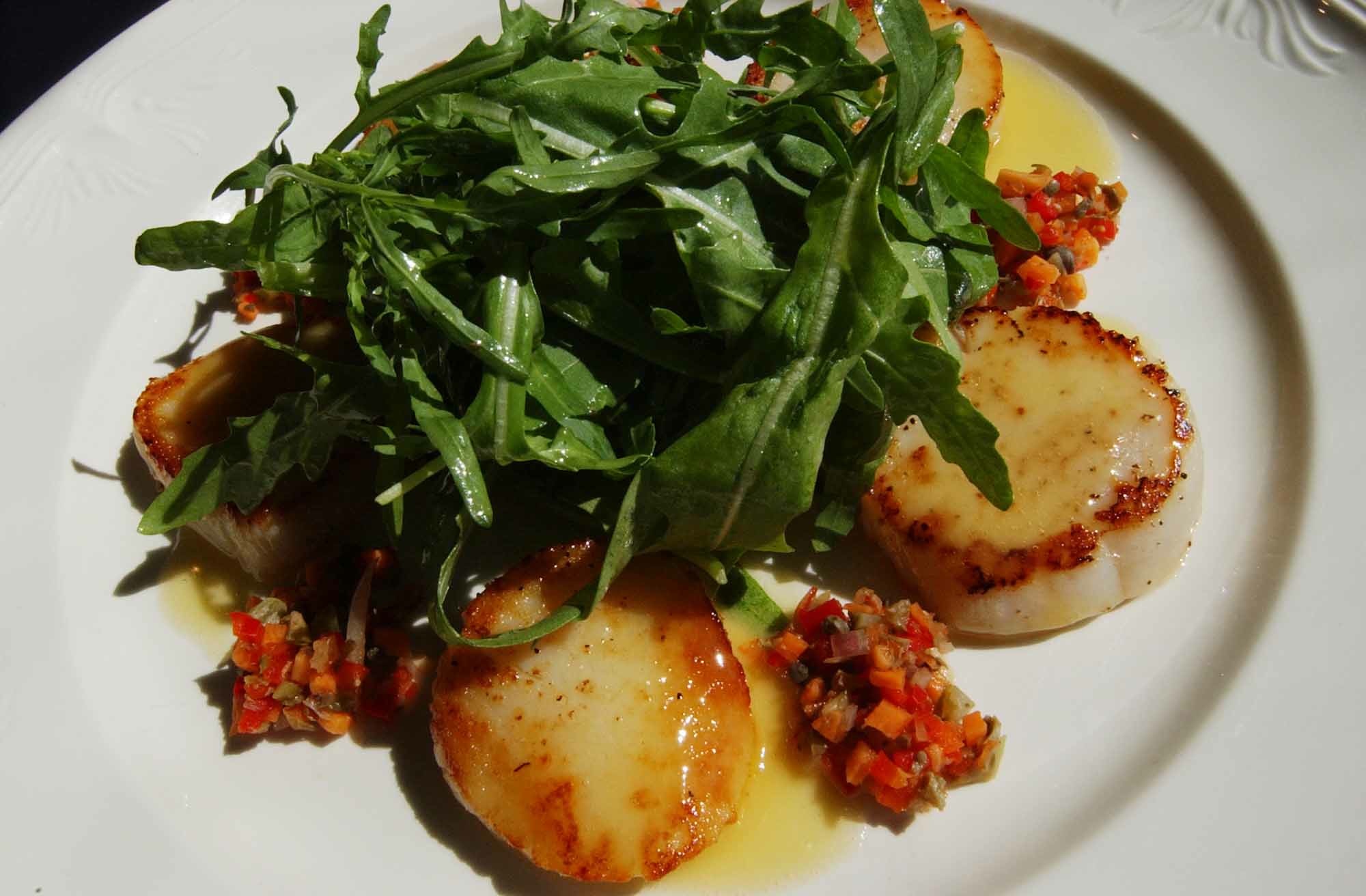 truffled risotto or wild bass with laverbread, The
juicy filet of Welsh black beef comes marvelously rich, sparked with a
black pepper sauce of classic breeding with shallots and
thyme-perfumed puree. Don't miss Nea;s Yard farmhouse cheeses with the
last of your wine or a glass of Port. And off to bed, drowsy and
contented that you have dined as well in Wales as anywhere in the UK
and slept as well as any traveler ever will.
truffled risotto or wild bass with laverbread, The
juicy filet of Welsh black beef comes marvelously rich, sparked with a
black pepper sauce of classic breeding with shallots and
thyme-perfumed puree. Don't miss Nea;s Yard farmhouse cheeses with the
last of your wine or a glass of Port. And off to bed, drowsy and
contented that you have dined as well in Wales as anywhere in the UK
and slept as well as any traveler ever will.
Dinner is set at
£70.
NEW YORK CORNER
GOTHAM BAR AND
GRILL
12 East 12th
Street (near Fifth Avenue)
212-620-4020
www.gothambarandgrill.com
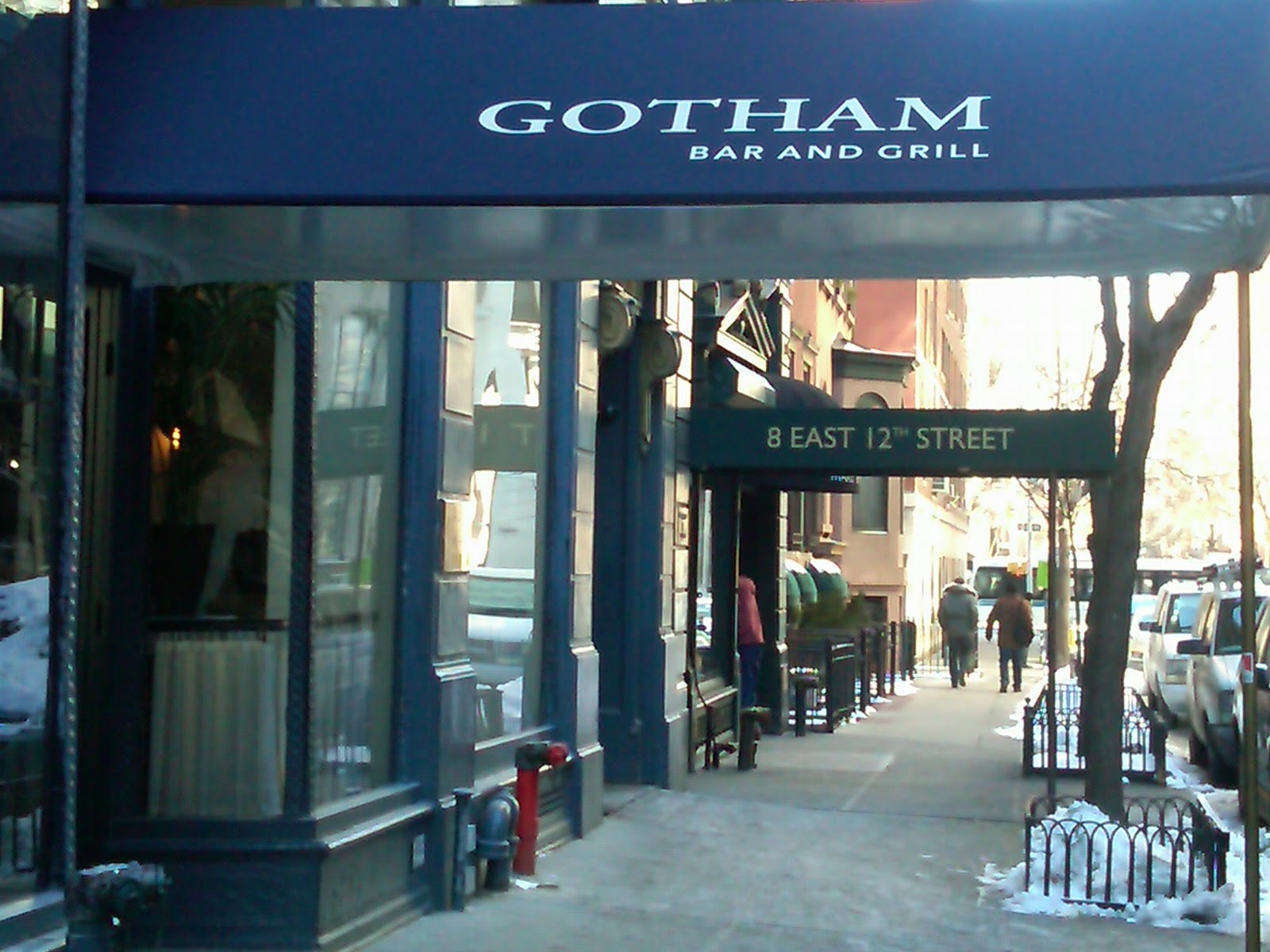 It
seems impossible that Gotham Bar and Grill opened 27 years ago, not
just
because time flies but because it seems as fresh and innovative as when
Chef Alfred
Portale took over the kitchen (and a partnership with original owners
Jeff Bliss, Jerry kretchmer, Tichard and Robert Rathe) two
years
into
its
wobbly
existence.
It
seems impossible that Gotham Bar and Grill opened 27 years ago, not
just
because time flies but because it seems as fresh and innovative as when
Chef Alfred
Portale took over the kitchen (and a partnership with original owners
Jeff Bliss, Jerry kretchmer, Tichard and Robert Rathe) two
years
into
its
wobbly
existence.
Walk in for the first time and you
might
well think the place is brand new and the hottest new restaurant in
town: It is
exceptionally handsome and gregariously large, with a long bar, perfect
lighting so that everybody can see everybody else, all done in creamy
colors
and glowing chandeliers. There’s
even a couple of steps down into the dining room, evoking a swank
nightclub
of the 1930s. Alas, there is
something missing now—the six-foot replica of the Statue of Liberty
that once
held her torch high about midway through the room. True, it might
have been a little kitschy but it was the
restaurant’s totem as much as the
giant octopus on the ceiling of Gargiulo’s or the jockeys outside “21”
Club.
Well,
she’s gone but everything else is the same and it sparkles as if the
restaurant just opened its doors last week, when I visited. The greeting is as cordial, the walk to
your table always has its sightings of celebs and regulars, and the
tablesettings are first class in every respect. The
noise
level
can
rise
because the place is always packed
by 8 PM, and it is clear that whoever comes here is here to eat, not to
goggle
or feel in the know.
Portale
has always served his own style of grownups’ food, never trendy, never
given
over to a fad for gourmet pizzas or meatballs. It is
a
style
famous
for
its “towering” dishes of lavishly
layered ingredients that was Portale’s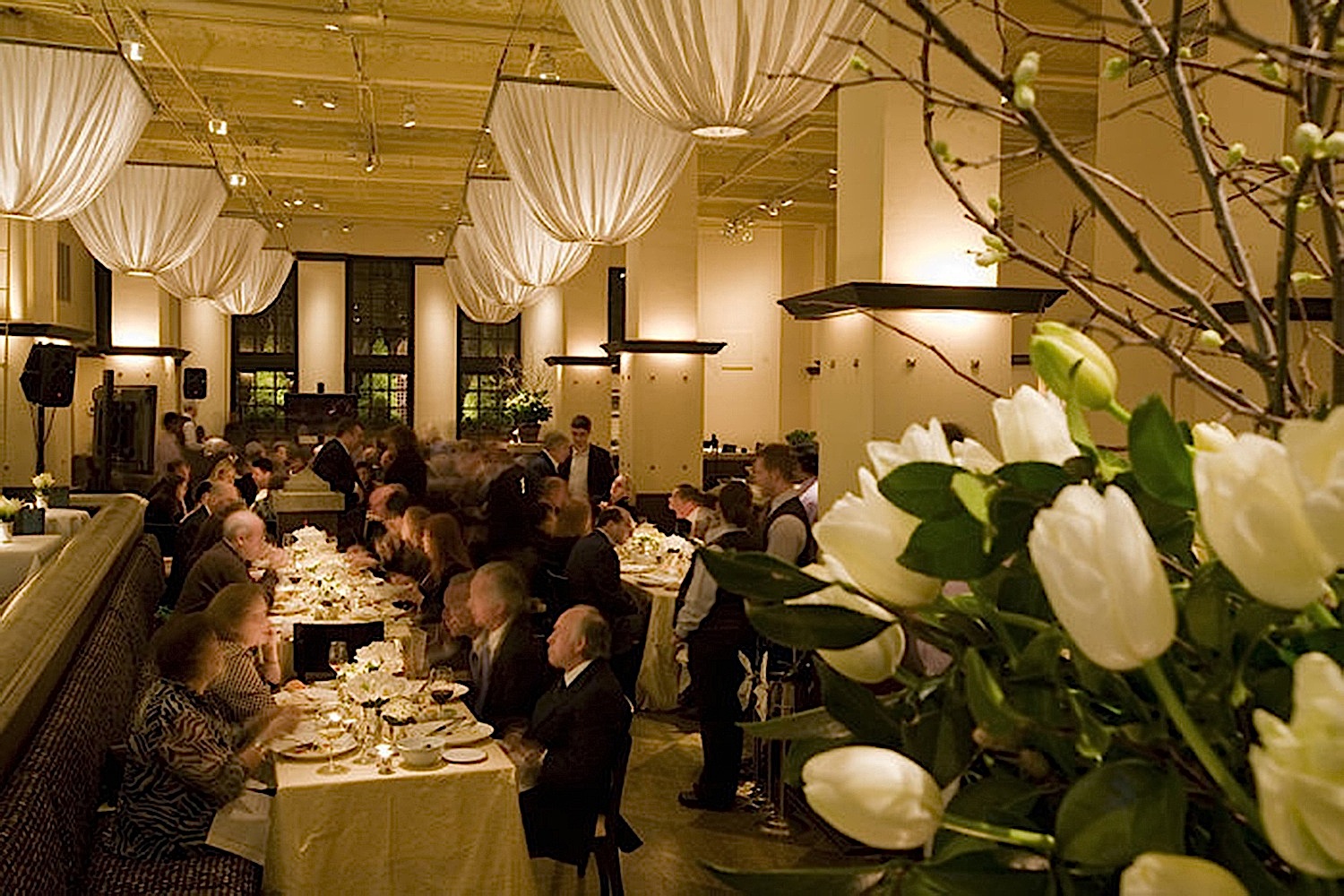 trademark early on and much copied
everywhere. He still layers some
dishes but they seem restrained so as not to seem a dated cliché. What he does do, and has done for 25
years, is to build in layers of rich flavors based on woodsy mushrooms,
bitter-salty greens, and impeccably reduced sauces.
trademark early on and much copied
everywhere. He still layers some
dishes but they seem restrained so as not to seem a dated cliché. What he does do, and has done for 25
years, is to build in layers of rich flavors based on woodsy mushrooms,
bitter-salty greens, and impeccably reduced sauces.
Thus,
a
seafood
salad
that
sounds
deceptively simple is a triumph of bright
flavors—scallops,
squid, Japanese octopus, lobster and avocado, all in particular balance. He makes a risotto with ruby red
shrimp, incorporating smoked bacon, roasted tomato, and wild arugula
for textural, sweet and saline notes. Goat’s cheese agnolotti seem simple
enough, but Portale brings them into a moist mélange of braised
chanterelle
mushrooms, baby leeks, sharp pecorino cheese. The
only
dish
I
thought
didn’t really click were lovely bay
scallops left raw, with a green apple geleem hearts of celery, lime, piment d’espelette;
I would much prefer the scallops just barely cooked in a little butter
or oil
to fatten up the dish.
Portale (below), along with
chefs Adam Longworth and Jacinto Guadarrama, here for 24 yrs), have
kept on some of Gotham’s
favorites, or at least I think the magnificent lobster with Thai
spices, water
spinach, snow peas, ginger, rice noodles in a kaffir lime broth has
been a
signature dish. In any case, it
seems as contemporary as any being served in New York and one hard to
resist. There is never any
question that Portale buys the finest ingredients because you taste
every one
of them in ever dish, unlike those of chefs who merely put a few dots
of some
ingredient on the rim of as plate or a few snippets of
vegetables on top of a
protein. Case in point, Gotham’s
superb grilled rack of lamb with Swiss chard, roast baby onions and
potato
puree—a classic rendering, with a marvelous reduction of the lamb pan
juices. Truffle-crusted Atlantic
halibut is a good concept, especially since cauliflower, baby leeks,
and a
mushroom fricassée with verjus
emulsion really perk up the basically bland
flavor of halibut.
on the rim of as plate or a few snippets of
vegetables on top of a
protein. Case in point, Gotham’s
superb grilled rack of lamb with Swiss chard, roast baby onions and
potato
puree—a classic rendering, with a marvelous reduction of the lamb pan
juices. Truffle-crusted Atlantic
halibut is a good concept, especially since cauliflower, baby leeks,
and a
mushroom fricassée with verjus
emulsion really perk up the basically bland
flavor of halibut.
Pastry chef Deborah Racicot
is in
perfect step with Portale’s ideas, rendering desserts like pistachio
soufflé
with Medjool dates and tangy Meyer lemon ice cream a class act, while
the equally
classic tangerine vacherin of perfect weight and texture takes on
nuances from
crisp meringues and white chocolate with poached Mandarin oranges.
Gotham’s
winelist,
800
labels
strong,
overseen
by sommelier and dining room manager Rick
Pitcher, is among
the exceptionally well chosen screeds in New York, but high-end
bottling
dwarf those under $100, and I’d like to see more below $50. But the selections are all there to
buoy Portale’s cuisine, as is everything else about this stellar
restaurant
that remains after three decades a Statue of Liberty-like beacon and
standard
bearer of New York style, grace and taste.
Gotham Bar and
Grill is open for lunch Mon.-Fri, for dinner nightly. Dinner
appetizers run $19-$28, main courses $34-$48, with a five-course
tasting menu
at $95.
❖❖❖
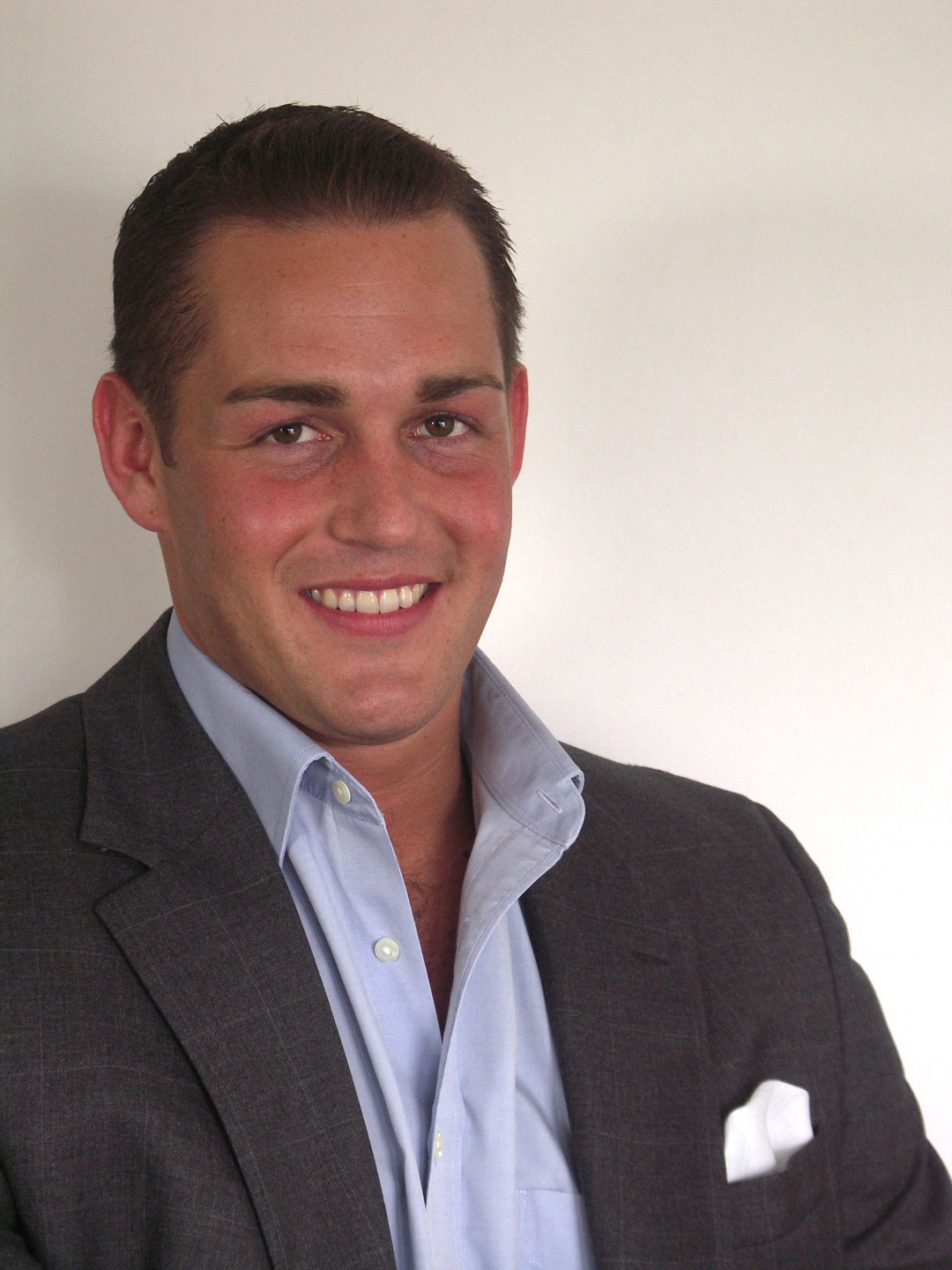
MAN ABOUT TOWN
by
Christopher Mariani
The Food Scene in the Caribbean. . .
Throughout
my
travels
to
the
different
islands of the Caribbean, I've realized
that the
restaurants are generally hit or miss. It is also evident that many of
the
islands share similar cooking styles and dishes that vary only
slightly. A significant percentage of the islands have good to really
good restaurants in
some of their major luxury hotels and an abundance of decent fun local
restaurants that try hard but are more about the experience than the
food. It
is well known that throughout the Caribbean, tourism boards and
government officials are now intervening and  placing
a
tremendous
importance
on
the
revamping of their island’s gastronomy, understanding that the bulk
of
their revenue comes from tourism, simply because tourists love to eat.
They are achieving
this improvement by setting up food and beverage schools to educate
local
citizens. These schools offer cooking classes, front-of-the-house
training,
wine seminars and management programs in an attempt to generate more
job
opportunities for locals, a trend I hope to see more of.
placing
a
tremendous
importance
on
the
revamping of their island’s gastronomy, understanding that the bulk
of
their revenue comes from tourism, simply because tourists love to eat.
They are achieving
this improvement by setting up food and beverage schools to educate
local
citizens. These schools offer cooking classes, front-of-the-house
training,
wine seminars and management programs in an attempt to generate more
job
opportunities for locals, a trend I hope to see more of.
Far too often I hear
from hotel general managers that local recruitment for staff among the
islands
is slim to none, which is why you will often stay at a high-end hotel
and be
greeted by a bellhop from Croatia, check in at the front desk by a
pretty Polish girl, and find the concierge is from France. At the
Ritz-Carlton in Grand Cayman,
they even list the staff’s home country directly underneath their name
tags.
This is a terrific way to add culture to a resort, but it is not
exactly
creating jobs for the locals. So it is nice to see a push for the
education and
expansion of job prospects for island natives within the hospitality
industry.
In my experience, it
has nothing to do with the capabilities of the locals but has
everything to do with
the ever-apparent mentality that so-called “Caribbean time” is
acceptable. “Caribbean
time” is the idea that everyone can and will be late by 45 minutes and
that’s
just the way it is. Maybe it’s because I’m from New York and am always
on the
go, or maybe it’s because I don’t like waiting 30 minutes for a taxi to
drive
me to a restaurant where I then wait another 30 minutes for my waiter
to
approach the table for my drink order that I become frustrated. I
guess I just don’t know how to
relax and kick back. Let’s make
this clear: I would never
expect a culture to feel obligated to adapt to a tourist; it should be
the
other way around, tourists should be the one respecting another’s
culture. But
when working in a restaurant or hotel (the hospitality industry), being
cordial
is not making your guests wait around until you feel ready to serve
them.
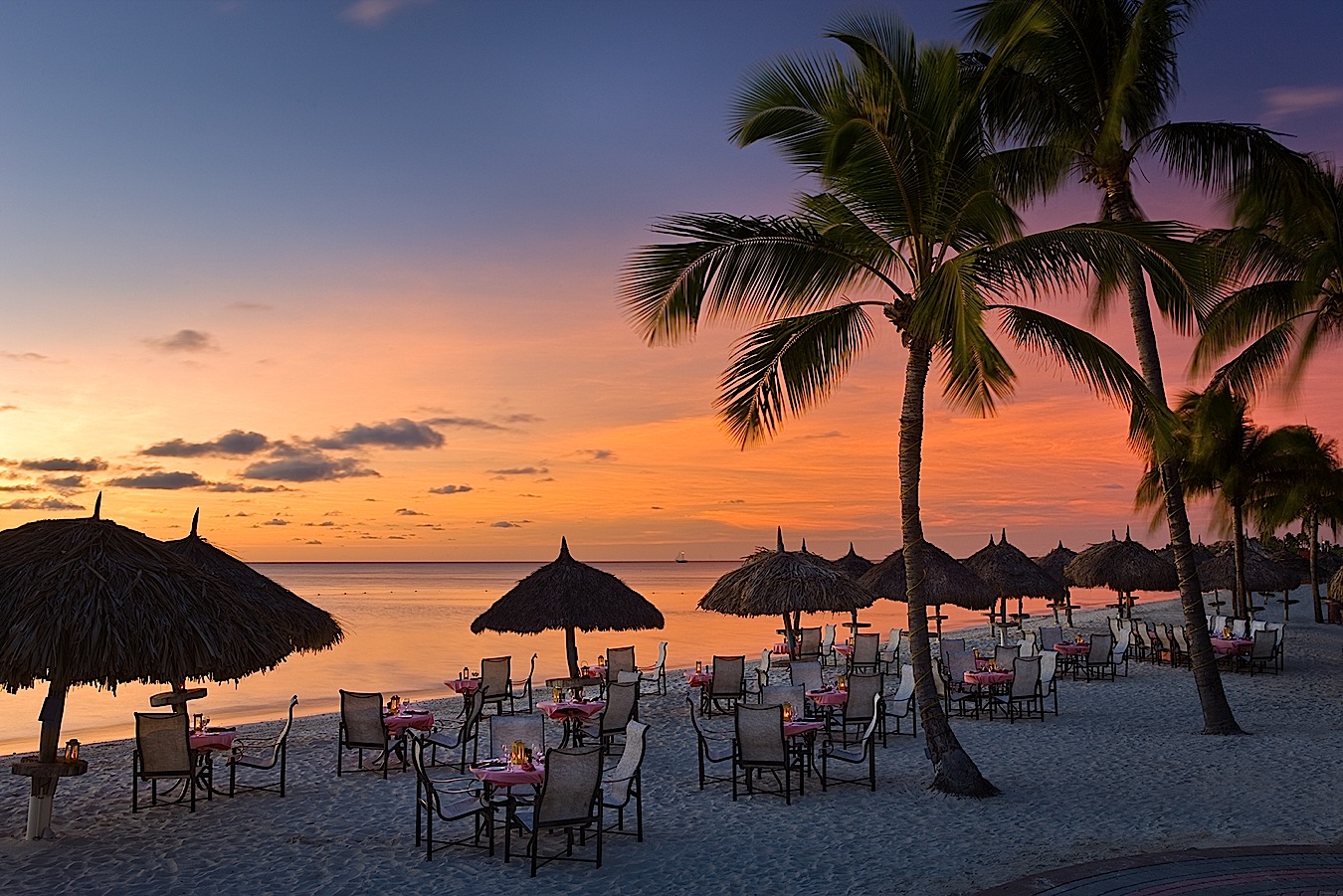 That said, two islands
where I did receive terrific service and even better food were
Anguilla and Grand Cayman. They both have a good balance of fine fare
restaurants and local eateries. The locals have sense of happiness that
translates
into every aspect of the island and its culture, and surprisingly
“Caribbean time” did not exist, they operated on “real time.” How odd.
That said, two islands
where I did receive terrific service and even better food were
Anguilla and Grand Cayman. They both have a good balance of fine fare
restaurants and local eateries. The locals have sense of happiness that
translates
into every aspect of the island and its culture, and surprisingly
“Caribbean time” did not exist, they operated on “real time.” How odd.
On
a
recent
trip
to
Aruba,
my first time, I was excited to explore and taste
what
the island had to offer in terms of restaurants and cuisine. And let me
start
by saying, Aruba thankfully operates on “real time.” After checking
into the Aruba
Marriott
Hotel
&
Casino, one of the largest hotels on the
island, I walked down to the hotel
restaurant, Simply Fish (left),
right
on
the
beach.
I sat down, ordered a drink
and looked out at the ocean as the sun began to set and glimmer off the
almost
placid water. There is something magnificent about eating on the beach
as the
heat begins to cool, the humidity lessens and the day turns to night
leaving
the flames from the torches, bright moon and stars responsible for the
only
light.
The menu at Simply
Fish is straightforward, offering eight appetizers, the shrimp ceviche
with
mango, avocado and lime juice one of the best. Also worth a try, the
grilled
shrimp lemongrass kebabs served with a sweet salsa. The main courses
are
generally seafood and large in portion, all fresh and enjoyable. The
friendly
service staff is easily the restaurant’s greatest attribute, smiling
men and
women who are simply there to make your dining experience as pleasant
as
possible. The Marriott also has a Ruth’s Chris Steak House and sushi
bar,
neither of which I dined at but it was nice to see multiple
dining options for guests staying on property.
Venturing
off
property
I
dined
at
a local bar on the water called Zeerover
(right), a
15-minute drive from the
Marriott and most other major hotels. Zeerover is a
great little outdoor spot occupied by a pool table, an old juke box in
the
corner playing Spanish music, a handful of tables surrounded by plastic
folding
chairs, and green Christmas lights used for decoration. There’s also a
wooden deck that extends to the dock where small single engine boats
come in
out and with the ocean’s freshest fish. Most tables are filled with
groups of
older gents and women sitting back with shades on drinking ice-cold
bottles of
Aruba’s own Balashi beer. Owner Eric Bisslik waits for the boats to
arrive as
he scans the daily catches and buys whatever fish he feels like cooking
that day. That afternoon, a giant wahoo came in and Bisslik chopped it
up into
chunks before his cook battered, then threw them into the deep
fryer along
with a few handfuls of shrimp and sliced plantains. This bowl of fried
delights (below)
came piping hot to the table and was sided by a glass container of hot
papaya
sauce for dipping. After a few Balashis and a stomach full of seafood,
I sat
back, soaked in some rays and stared out at the beautiful ocean as the
clouds
slowly passed above. Zeerovers is not often visited by tourists and is
considered
to be an island secret; that’s part of its charm. So when in Aruba, stop
by
for
lunch
but
don’t
tell too many people about how great it was.
The
following
evening
we
dined
at
Gostoso Restaurante, a festive
restaurant in
Oranjestad that had a surprisingly complex menu with some dishes not
often placed
on an island menu. The dishes are generally Portuguese and
Arubian-influenced,
but there are little hints of Japanese and Italian that create an
interesting
twist. One of my favorite appetizers was a deep-fried sushi roll with a
sweet
and tangy soy sauce. There were also traditional Aruban dishes such as
the cabrito
stoba,
a mixture of goat, cilantro, red peppers , and rosemary in a red wine
sauce, along
with the lenga stoba, stewed
beef tongue cooked in garlic, onions, tomato and
scallions. All Arubian dishes here are cooked with a deep sense of
flavor and quite
a bit of flair for an uncomplicated island restaurant. From the
Portuguese
menu, a generous portion of New York strip hangs on a kebab after being
marinated
with bay leaves, garlic and sea salt. Chef/owner Jode Do Nascimento
works
nightly along with his lovely wife as local waitresses orchestrate an
extremely
fluid service.
The
last
restaurant
was
more
beautiful
than tasty but definitely worth a visit.
The Kunuku House (right) was originally an
old farmhouse built over 150
years ago that has now been converted into a functioning restaurant.
Ask to be
toured around and try to envision what the rooms would have looked like
for the
past 150 years as you enter
the
master
bedroom,
which
now has a handful
of tables and is painted a light powder pink. The rooms jut off
from one
another as you may find yourself dining in the children’s bedroom or
possibly
the living room. The Spanish architectural house has its windows in
line with
the north-east trade wind for a cooling breeze along with very thick
walls,
covered by a saddle roof for natural cooling. Along the perimeter of
the house
is a transhi
stone fence formerly used to protect the cultivation from stray goats.
We dined
outside on the patio where a cool breeze blessed the
island that night. Most dishes are good. Stick to the fried selections,
order a
cocktail
and enjoy the atmosphere.
Beyond
the
tropical
weather,
always-bright
sun
and gorgeous white sand beaches,
Aruba
has evolved from a stereotypical laid back “Caribbean time” island that
still
haunts many of its neighbors. As many, if not all of all the islands
found in
the Caribbean, Aruba is a coastline paradise with an interior that
offers not
much more than shrubbery and an almost desert-like terrain, but Aruba
distinguishes
itself with its collection of pleasurable restaurants and its wonderful
staff.
❖❖❖
NOTES
FROM
THE
WINE
CELLAR
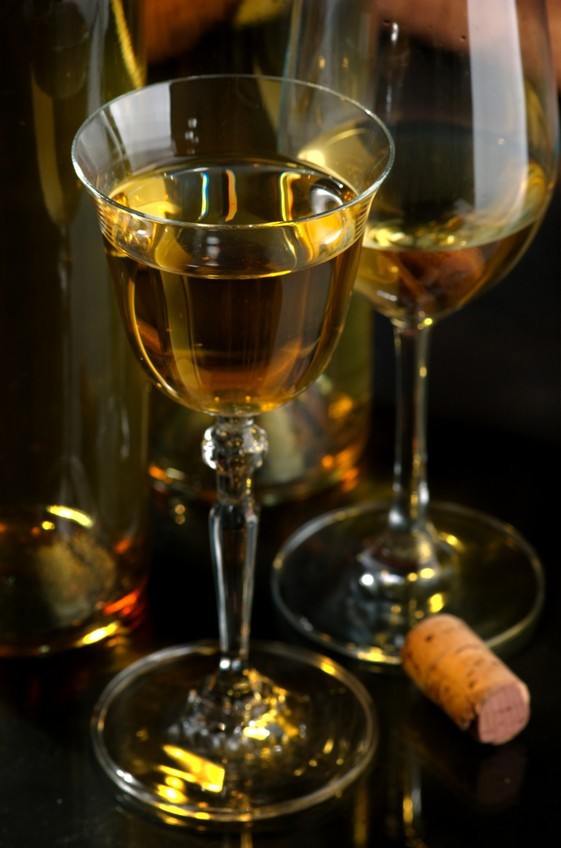 Muscat
Does Not Live by Aroma Alone
Muscat
Does Not Live by Aroma Alone
by Mort Hochtein
On an
airplane recently, a stranger in an adjoining seat observed
me
studying files and deduced that I knew something about
wine.
Unbidden, he started a conversation with a test: “If you’re so smart,”
he
ventured, “what‘s my favorite wine?” Somehow, perhaps because I
had been
reading about it the day before my flight, Muscat de
Beaumes-de-Venise popped into my mind, and I tossed the name of
that
southern Rhone “stickie” at my seatmate. I’d hit it right from out of
nowhere
and overwhelmed by my acuity, I am happy to say, that shot
silenced
my querulous companion for the remainder of our flight.
I
like Muscat in all its forms, sparkling as in airy, feather-light Asti
spumante
from Italy, blended, fortified, aged, and bulked up like a heavyweight
boxer in
rare and pricey bottlings from Rutherglen in Australia,
elegant in
the refined style of Zind-Humbrecht in Alsace, tantalizingly sweet as
in
Moscato d’Oro from Robert Mondavi in California and in all its infinite
varieties from the many vineyards where it grows.
There are more than 200
varieties and derivatives in the Muscat family. Muscat of Alexandria
and Muscat
Blanc a Petits Grains are the most common. Among other prominent
offshoots,
Austria fields a Gelber Muskateller and a Muscat Ottonell, while Muscat
Cannelli and Orange Muscat spring up in California.
In its more prevalent light and fragrant variations, Muscat makes the
perfect
aperitif or dessert wine, satisfying on its own, better when paired
with a
simple sponge cake, flan or Swiss Roll, delectable when
paired with
Fois Gras, and dangerously overmatched by cheeses of any sort. I’ve
made it a
point to sample Muscats wherever I travel and it has been a rewarding
quest.
Every
two year, French producers stage a rolling
tasting called
de’couvertes en Valle du
Rhône
(discoveries in the valley of the Rhône), a week of
daily
tastings and excellent buffets starting in the north below
Lyon,
and working south along the river to the delta below Avignon
feeding into
the Mediterranean. I joined the most recent caravan
at stage
one at the ancient city of Vienne and as we sampled
our way
through oceans of Côte-Rotie, Condrieu,. Saint Joseph and
Hermitage. I lusted
for day three when I could satisfy my thirst for fresh,
young
Muscat de Beaumes de Venise.
When
that
occasion
arrived
at
the Salle des Fêtes in Beaumes-De-Venise, I followed the crowd,  figuring the
locals know what’s best. The biggest cluster was around the table for
the Domaine de la Pigéade.
And
for
good
reasons,
because the Pigéade, a pale gold
pleaser, its perfumed nose redolent of honey and apricot tones, is a
rare, primarily bespoke and expensive wine. Smooth with
honey
and apricot fruit, elegant on the palate, its sweetness tempered
perfectly by a
tweak of acid, the Pigeade is worth searching out. I found
375ml bottles online in two California stores,
K&L
($14.99) and Backroom Napa ($17.)
figuring the
locals know what’s best. The biggest cluster was around the table for
the Domaine de la Pigéade.
And
for
good
reasons,
because the Pigéade, a pale gold
pleaser, its perfumed nose redolent of honey and apricot tones, is a
rare, primarily bespoke and expensive wine. Smooth with
honey
and apricot fruit, elegant on the palate, its sweetness tempered
perfectly by a
tweak of acid, the Pigeade is worth searching out. I found
375ml bottles online in two California stores,
K&L
($14.99) and Backroom Napa ($17.)
It was also difficult to get to the Domaine
de Durban table, and again, rewarding. The ’09 Durban is slightly
weightier, ripe with scents of white flowers, mandarin and pears,
morphing into more tropical flavors of pineapple, peach and marmalade
that
linger long on the palate. Priced between $18 and $25, it is
generally
more available than the Pigeade. My number three muscat was the 2009
Domaine
des Bernardins, more amber in color, with a slight tang of pepper
on the
nose, medium full bodied and rich in pineapple and figs and a hint of
molasses.
An elegant wine, it retails for about $18.
 There are four
communes in the Muscat appellation
and many small farms belong to cooperative, the largest of which
is Vignerons de Balma Venitia. The co-op wine is medium bodied,
with
apricot and pineapple flavors, and was a close fourth in my
rankings.
Retail in the U.S. is $16 to $20, and Balma Venitia is also
available in kosher style. Sherry-Lehman in
New York carries the kosher 2006 Balma Venitia Muscat de Beaumes de
Venise at
$17.95 for a 750ml bottle.
There are four
communes in the Muscat appellation
and many small farms belong to cooperative, the largest of which
is Vignerons de Balma Venitia. The co-op wine is medium bodied,
with
apricot and pineapple flavors, and was a close fourth in my
rankings.
Retail in the U.S. is $16 to $20, and Balma Venitia is also
available in kosher style. Sherry-Lehman in
New York carries the kosher 2006 Balma Venitia Muscat de Beaumes de
Venise at
$17.95 for a 750ml bottle.
If
I
say
I
had to fight crowds with
these four, it was hardly easy to get near the other major
producers—Vignobles la Coterie,
which
is
also
a
co-op, Domaine
Beaumalric, Domaine de Fenouillet and Domaine de Bouletin. But it was
definitely worth the battle and I left, my thirst for
muscat
satisfied, if only for the day.
I saw the ’08 Durban by the
glass at the bar in 59 East 59 Theater in New York City, and I am sure
it is
available on many restaurant wine lists, doubling as an aperitif or an
after
dinner sweet drink. Knowing that Sondra Bernstein’s
restaurant, The Girl and the Fig in Sonoma, has an
extensive
Rhône selection. I checked there and found an ’06
Durban by the
glass at $10. As Michelin might say, worth the detour.
Mort
Hochstein,
former
editor
and
producer
for NBC News and the Today Show, and
former managing editor of Nation's Restaurant News, writes on
wine, food
and travel for Wine Spectator, Wine Business Monthly, Saveur and
other
food and wine publications.
✉ Guidelines for submissions: QUICK BYTES publishes events, special dinners, etc, open to the public. When submitting please send the most pertinent info, including tel # and site, in one short paragraph as simple e-mail text, WITH DATE LISTED FIRST, as below. Thanks. John Mariani
| Mondays beginning March 21, in Chicago, Frontier will feature a prix fixe dinner half-prices bottles of wine including Kim Crawford Sauvignon Blanc (regularly $42), Mumm Pinot Noir (regularly $32), Provenance Merlot (regularly $54), Tintara Shiraz (regularly $36) and more. Created by Executive Chef Brian Jupiter, the prix fixe dinner will include a choice of 4-courses including soup (Oyster and Artichoke Bisque) or salad, an appetizer (Duck Tacos), entrée (Slagel Family Farm Meatloaf) and dessert. $30 pp. Call 773.772.4322 or visit www.thefrontierchicago.com |
|
On March
28 - 31 in Astoria, NY,
MexiQ
Kitchen
&
Draught is partnering with
Tuthilltown Spirits to host a Hudson Whiskey pairing
dinner.
Executive Chef Jonathon VanSleet has created four courses of
Mexican-American barbecue dishes which will enhance the flavor of each
locally-distilled whiskey. $45 pp. Call 718-626-0333 or visit
www.mexiqny.com |
| On March 30, Texas de Brazil in Chicago, IL, will host a Chicago Hotel Concierge Association Fundraiser benefitting Share Your Soles, the CHCA Assistance Fund, and Les Clefs d'Or 2013 Congress. Guests will enjoy beer, wine, complimentary passed hors d'oeuvres, casino games and a silent auction. $35pp, $30 with a donation of gently used shoes. Call 312-670-1006 or visit www.texasdebrazil.com. |
| On March 31, in Atlanta, RA Sushi is hosting a Maki Madness sushi-eating contest to coincide with NCAA March Madness. The contest is organized into a bracket system and competitors will be eating RA Sushi’s signature Tootsy Maki. The grand prize eater will win sushi for a year. Food and drink specials will be available all day for guests. Deadline to register is March 29, and the contest is limited to first 40 entries. No cost to register. Call 404-267-0114 or visit www.RAsushi.com. |
| Through March 31 in San Francisco, CA, Ozumo will donate 100% of the proceeds of their Kibou No Hana (“flower of hope”) specialty cocktail to Japan tsunami relief efforts. Call (415) 882-1333 or visit www.Ozumo.com. |
|
On March
31, Nombe in San
Francisco, CA, will host a Sake 101, Primer on Sake
Pairing with all proceeds going to the Japan Disaster Relief
fund.
Dinner will showcase four traditional styles and a 4-course meal.
Special guest will be Yuka Takahashi, sister, to Nombe partner, Mari
Takashahi, who left Japan 4 days after the quake and will share her
compelling experiences. Industry donors include Youngs Market, ABS
Seafood, VegiWorks, Golden Gate Meat Company, and Modesto
Chicken.
Highlight of dinner is 18-yr-old koshu (aged) sake served by Sake
sommelier and Nombe partner, Gil Payne. $45pp. 415.681-7150
or visit www.nombesf.com. |
| On March 31, Foreign Cinema in San Francisco, CA will host a very special evening with Winemaker Eric Sussman of Radio-Coteau. Sussman and Wine Director Zach Pace will take guests through a food and wine journey take guests through a food and wine journey as they pair the flavors of Foreign Cinema’s seasonal, California-Mediterranean cuisine with select library wines featured alongside current releases from the venerable Radio-Coteau. This dinner will take place in the restaurant’s intimate Mezzanine and will include a 4-course menu with wine pairings for $100pp. Space is limited to 27 guests. Call 415-648-7600. |
|
From March
31 to April 3 in Austin, TX, Whole Foods Market
presents The Texas Hill
Country Wine & Food Festival, which unites innovative culinary
artisans, wine producers, and the general public to celebrate the rich
traditions that influence TX wine and food. Now in it's 26th year, the
festival welcomes more than 30 chefs and culinary experts from across
the globe, and features 18 unique wine and food events at top
restaurants, hotels, and venues throughout the area. Attendees can
engage with Chefs like Tyson Cole of Uchi/Uchiko, learn from TIME
magazine columnist Josh Ozersky, and experience wine from various TX
vineyards. For more information and to purchase tickets visit www.texaswineandfood.org or
call 512-249-6300. |
|
On April 1
and 2, Hop Scotch Spring Beer
& Scotch Festival in Seattle,
WA,
features beer, wine, Scotch and tequila tasting at Fremont Studios. $25
pp. Call 206-633-0422 or visit www.hopscotchtasting.com |
|
On April 2
to April 9, Atlanta will host the 1st ever
Hotel Restaurant Week. Nine
hotel restaurants are participating and will each serve a $25 pp.
3-course meal. Visit www.hotelrestaurantweek.com.
|
| On April 3, Candyality in Chicago will host an Afternoon with Cub’s starting pitcher, Ryan Dempster. Come meet Ryan and discuss your favorite candy as he signs in as Candyality’s Celebrity Candy Specialist for the afternoon. Ryan will autograph Mini Candy Bins filled with the ever popular red, white, and (cubbie) blue-Cubbie Gummie Bears with proceeds from the sales of this and the Sweetest Cub’s Fan Raffle going to the Ryan & Jenny Dempster Family Foundation. 773-472-7800 or visit www.candyality.com. |
| On April 5 in NYC, Maestro Steven Blier continues the spring season of HENRY’s “Sing for Your Supper.” An evening of great music provided from New York City’s rising stars of musical theatre and opera and Chef Mark Barrett’s famous Baked Veal Ricotta Meatballs featured in the 3-course, Italian-American prix-fixe dinner. “Sing for Your Supper” will sell out, so please reserve your table now! Call 212-866-0600 for reservations or visit www.henrysnyc.com. |
| On April 5 L’Auberge Chez Francois restaurant in Great Falls, VA, will host an Alsatian Wine Tasting Dinner. Owner and wine maker, Catherine Fallar, of Domain Weinbach, one of the top wineries in Alsace, will be presenting new wines and answering questions. Chef Jacques Haeringer will pair wines with a five-course meal. Price $125 per person all inclusive. To reserve spaces go to www.ChefJacques.com or call the restaurant: 703-759-3800. |
| On April 13 in Denver, CO The Ritz-Carlton's signature restaurant, ELWAY'S Downtown will host a Johnnie Walker five-course pairing dinner featuring a seasonal menu by ELWAY'S Chef Robert Bogart. Attendees will get to meet the House of Walker's Whiskey Master, Robert Sickler. Selected Scotch blends include Johnnie Walker Red Label, Green Label, Blue Label, Black Label and Gold Label. $75 pp plus tax and gratuity. Call 303-312-3107 or visit www.elways.com. |
Any of John Mariani's books below
may be ordered from amazon.com.
" A fact-filled,
entertaining history [that] substantiates its title with hundreds of
facts in this meaty history of the rise of Italian food culture around
the
globe. From Charles Dickens's journey through Italy in 1844 to
20th-century
immigrants to America selling ice cream on the streets of New Orleans,
Mariani
constantly surprises the reader with little-known culinary anecdotes
about
Italy and its people, who have made pasta and pizza household dishes in
the
U.S. and beyond."--Publishers Weekly "Equal
parts
history,
sociology,
gastornomy,
and
just
plain
fun,
How
Italian
Food
Conquered
the
World
tells
the captivating and delicious story of
the (let's face it) everybody's favorite cuisine with clarity, verve
and more than one surprise."--Colman Andrews, editorial director of The Daily Meal.com. "A
fantastic and fascinating read, covering everything from the influence
of Venice's spice trade to the imnpact of Italian immigrants in
America and the evolution of alta cucina. This book will serve as a
terrific resource to anyone iunterested in the real story of Italian
food."--Mary Ann Espositio, hosty of PBS-TV's Ciao Italia. "John
Mariani
has
written
the
definitive
history
of
how
Italians
won
their
way
into
our
hearts,
min ds, and stomachs. It's a story of
pleasure over pomp and taste over technique."--Danny Meyer, owner of
NYC restaurants Union Square Cafe, Gotham Bar & Grill, The Modern,
and Maialino.
|
 |
 |
 |
 |
 |
 |
 |
 |
❖❖❖
 Everett
Potter's
Travel
Report:
Everett
Potter's
Travel
Report: I consider this the best and savviest blog of its kind on the web. Potter is a columnist for USA Weekend, Diversion, Laptop and Luxury Spa Finder, a contributing editor for Ski and a frequent contributor to National Geographic Traveler, ForbesTraveler.com and Elle Decor. "I’ve designed this site is for people who take their travel seriously," says Potter. "For travelers who want to learn about special places but don’t necessarily want to pay through the nose for the privilege of staying there. Because at the end of the day, it’s not so much about five-star places as five-star experiences." THIS WEEK: 10 Ways to Beat High Airfares This Summer

❖❖❖
 Eating
Las
Vegas is the new on-line site for Virtual Gourmet
contributor John
A. Curtas., who since 1995 has been commenting on the Las Vegas food
scene and reviewing restaurants for Nevada Public Radio. He is
also
the restaurant critic for KLAS TV, Channel 8 in Las Vegas, and his past
reviews can be accessed at KNPR.org.
Click
on
the
logo
below
to
go
directly
to
his
site.
Eating
Las
Vegas is the new on-line site for Virtual Gourmet
contributor John
A. Curtas., who since 1995 has been commenting on the Las Vegas food
scene and reviewing restaurants for Nevada Public Radio. He is
also
the restaurant critic for KLAS TV, Channel 8 in Las Vegas, and his past
reviews can be accessed at KNPR.org.
Click
on
the
logo
below
to
go
directly
to
his
site.
❖❖❖

Tennis Resorts Online: A Critical Guide to the World's Best Tennis Resorts and Tennis Camps, published by ROGER COX, who has spent more than two decades writing about tennis travel, including a 17-year stretch for Tennis magazine. He has also written for Arthur Frommer's Budget Travel, New York Magazine, Travel & Leisure, Esquire, Money, USTA Magazine, Men's Journal, and The Robb Report. He has authored two books-The World's Best Tennis Vacations (Stephen Greene Press/Viking Penguin, 1990) and The Best Places to Stay in the Rockies (Houghton Mifflin, 1992 & 1994), and the Melbourne (Australia) chapter to the Wall Street Journal Business Guide to Cities of the Pacific Rim (Fodor's Travel Guides, 1991).


The Family Travel Forum
- A community for those who
"Have Kids, Still Travel" and want to make family vacations more fun,
less work and better value. FTF's travel and parenting features,
including
reviews of tropical and ski resorts, reunion destinations, attractions,
holiday
weekends, family festivals, cruises, and all kinds of vacation ideas
should be
the first port of call for family vacation planners. http://www.familytravelforum.com/index.html
ALL YOU NEED BEFORE YOU GO
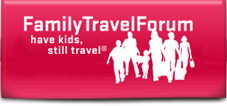
nickonwine: An engaging, interactive wine column by Nick Passmore, Artisanal Editor, Four Seasons Magazine; Wine Columnist, BusinessWeek.com; nick@nickonwine.com; www.nickonwine.com.

MARIANI'S VIRTUAL GOURMET NEWSLETTER is published weekly. Editor/Publisher: John Mariani. Contributing Writers: Christopher Mariani, Robert Mariani, John A. Curtas, Edward Brivio, Mort Hochstein, Suzanne Wright, and Brian Freedman. Contributing Photographers: Galina Stepanoff-Dargery, Bobby Pirillo. Technical Advisor: Gerry McLoughlin.
Click Here to return to John Mariani's
Homepage
© copyright John Mariani 2011

